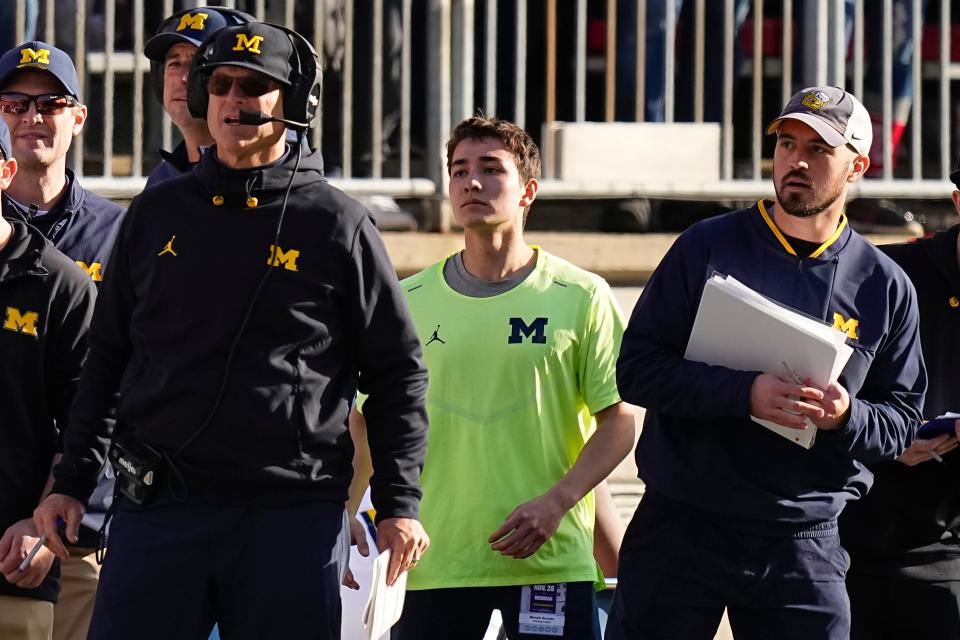Oller: Did Michigan gain advantage from allegedly spying on Ohio State in 2021-22? Hmmm
Connor Stalions has gone away, but his clandestine 007 operation continues to shake and stir college football.
The latest: Ohio State records show Stalions purchased 27 tickets, some of which went unused, to 12 OSU home games between 2021-23. The majority of seats were located in Section 20 or 22, across from the Buckeyes sideline, but other sections were involved as well.
None of this proves beyond a shadow of a doubt that Stalions, or more likely those in his alleged sign-stealing network, were spying on OSU with camera phones in hand, but where there is smoke …
The question becomes whether that fire burned the Buckeyes in losses to the Wolverines in 2021 and 2022. (Stalions resigned after the scandal broke, weeks before UM's 30-24 win Saturday in Ann Arbor, so don’t blame that loss on sneaky undercover activity).
Before diving in, one absolute must be mentioned: If anyone is the victim here, it is Ohio State. How much of a victim has yet to be determined, but this line that "everyone does it so everyone is guilty" is malarkey. Most teams attempt to steal signs within the rules, from the sidelines during games. Stalions, who was a Michigan staffer, is accused of breaking NCAA rules by stealing signs through advanced scouting, including paying for tickets so sneaks could film signals from the seats.
How much did the sign-stealing benefit Michigan in its 42-27 home win against OSU in 2021 and its 45-23 win the next year in Columbus? A little? A lot? Not at all?
The assumption, at least by many Ohio State fans, is that the Wolverines would not have won those games without knowing beforehand what offense and defense the Buckeyes would run. The counter argument is that Saturday’s win proved otherwise. The Wolverines bested OSU fair and square, dominating the line of scrimmage during the second half the same way they did in 2021.
How you view the controversy is something of a Rorschach test – you see what you want to see, at least until what you see is proved false.
Gerry DiNardo wants such proof before issuing a verdict on if, or by how much, Michigan benefited from stealing signs.
DiNardo, a former coach at Vanderbilt, LSU and Indiana who now works for the Big Ten Network, spoke of sign-stealing in general without weighing in on the OSU-UM question.

“The 10,000-mile high view is that it certainly impacts the game and balance of competition,” DiNardo said Wednesday. “No doubt if you know what’s coming you have a competitive advantage, but so is having a great quarterback. It comes down to was it within the rules?”
That difference makes all the difference, DiNardo said, because the effectiveness of spying done within the rules is limited by those rules, and once rules are broken, the extent of how far someone will go to gain an edge is unrestricted.
“To say that knowing the signals isn’t important is contradictory to everyone doing it within rules,” said DiNardo, explaining that if sign stealing was pointless it would not be “general practice” to do it.
The fact coaches change their signals also confirms that sign stealing has a competitive impact, he said.
“Now, what advantage that plays for a team all depends,” DiNardo said. “The closer the two teams are in ability and talent and competition, the more impact it would have. If one team is far better, and the end result likely would be that team would be favored by the experts anyway, it would have little impact other than margin of victory.”
In 2021, when Michigan defeated Ohio State by 15 points, the storyline was how the Wolverines were tougher at the point of attack. UM rushed for 297 yards and held the Buckeyes to 64. You give up nearly 300 yards on the ground, you’re likely to lose.
The flip side is Michigan gashed OSU’s defense because it knew its defensive signals, but DiNardo rejects that explanation.
“It’s probably too late to get that info to the team if I’m a defensive coordinator … so it’s not as much of an advantage to break defensive signals as offensive,” he said.
DiNardo also does not buy the notion that Michigan’s 15-point victory margin in 2021 and 22-point margin in 2022 should be attributed to sign stealing. At least not yet.
“I’m not willing to agree the scores would be different unless the investigation is over and it’s proven,” he said.
Even then, DiNardo is a firm believer that game film is the most trustworthy witness to take the stand.
“I’m a big believer in film study,” he said. “If I was pressed to say (sign stealing) changed a game, I might watch video and see. If every time it’s a pass and the lineman goes from a four-point stance to a three-point stance, or you see the cornerback back up three yards and move inside the hashmark, you could – with technology – prove it did make a difference.”
Final thought: Two things can be true at once. Michigan could have gained no discernible competitive advantage against Ohio State and yet the Wolverines still cheated. By definition, cheating is breaking the rules in an attempt to gain an advantage. Results do not matter. Win or lose, it’s cheating. If Stalions broke NCAA rules, Michigan cheated. Deal with it.
Get more Ohio State football news by listening to our podcasts
This article originally appeared on The Columbus Dispatch: Ohio State football finds little solace in Michigan cheating scandal
